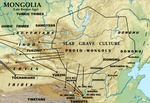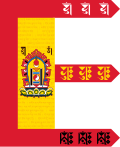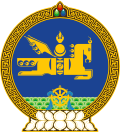The culture of Mongolia has been shaped by the country's nomadic tradition and its position at the crossroads of various empires and civilizations. Mongolian...
32 KB (3,657 words) - 15:20, 26 October 2024
Horses and horse culture play a large role in the daily and national life in Mongolia. It is traditionally said that "A Mongol without a horse is like...
62 KB (9,486 words) - 12:55, 22 October 2024
early stages of the Saka culture (particularly the Arzhan, Chandman and Pazyryk cultures) in the area from the Altai to Western Mongolia. Deer stone art...
81 KB (9,909 words) - 02:08, 30 December 2024
Mongolia, officially the State of Mongolia, is a landlocked country in East Asia, bordered by Russia to the north and China to the south. It covers an...
143 KB (14,591 words) - 04:31, 2 January 2025
Ulaanzuukh culture, also Ulaanzuukh-Tevsh culture (Ch:乌兰朱和文化, c. 1450-1000 BCE), is an archaeological culture of the Late Bronze Age eastern Mongolia. It likely...
11 KB (1,186 words) - 02:35, 10 November 2024
Slab Grave culture is an archaeological culture of Late Bronze Age (LBA) and Early Iron Age Mongolia. The Slab Grave culture formed one of the primary...
33 KB (4,058 words) - 05:51, 30 December 2024
Music is an integral part of Mongolian culture. Among the unique contributions of Mongolia to the world's musical culture are the long songs, overtone...
13 KB (1,539 words) - 13:03, 22 July 2024
Mongolia, confirming a further expansion about 1,500 km beyond the Altai Mountains. The Afanasievo culture is now considered as an integral part of the...
62 KB (6,056 words) - 22:17, 14 November 2024
Irkutsk Oblast and Zabaykalsky Krai. This culture is the main archaeological find of the Bronze Age Mongolia. Deer stones (also known as reindeer stones)...
126 KB (16,838 words) - 00:00, 16 December 2024
(March 1) Mongolian military day (March 18) Health Day (April 7) Intellectual Property Day (April 26) Family Day (May 15) National literary culture and book...
3 KB (112 words) - 12:07, 8 December 2024
Mongolia under Qing rule was the rule of the Manchu-led Qing dynasty of China over the Mongolian Plateau, including the four Outer Mongolian aimags (a...
48 KB (5,776 words) - 17:57, 21 July 2024
The Chandman culture, also known as Chandmani culture, was a nomadic culture that existed in northwestern Mongolia and southern Siberia during the Iron...
12 KB (1,287 words) - 01:20, 21 April 2024
article on the demographics of Mongolia include population density, ethnicity, religious affiliations, and other aspects of the population. All data are...
58 KB (1,349 words) - 16:43, 1 January 2025
contains Mongolian script. Without proper rendering support, you may see question marks, boxes, or other symbols instead of text in Mongolian script. Inner...
107 KB (9,959 words) - 15:53, 25 November 2024
Munkhkhairkhan culture, also Munkh-Khairkhan or Mönkhkhairkhan was a Middle Bronze Age culture of southern Siberia and western Mongolia, named after Mönkhkhairkhan...
6 KB (460 words) - 15:41, 26 June 2024
Yurt (redirect from Mongolian yurts)
A yurt (from the Turkic languages) or ger (Mongolian) is a portable, round tent covered and insulated with skins or felt and traditionally used as a dwelling...
20 KB (2,217 words) - 00:08, 7 December 2024
Ulaanbaatar (redirect from Capital of Mongolia)
anglicized as Ulan Bator, is the capital and most populous city of Mongolia. It has a population of 1.6 million, and it is the coldest capital city in the world...
101 KB (9,846 words) - 05:49, 3 January 2025
Bronze Age archaeological culture of western Mongolia and the borders of neighbouring countries, such as the Dzungarian Basin of Xinjiang and eastern Kazakhstan...
25 KB (2,658 words) - 01:20, 21 April 2024
The Bogd Khanate of Mongolia was a de facto country in Outer Mongolia between 1911 and 1915 and again from 1921 to 1924. By the spring of 1911, some prominent...
46 KB (5,249 words) - 03:30, 29 December 2024
religion in Mongolia practiced by 51.7% of Mongolia's population, according to the 2020 Mongolia census. Buddhism in Mongolia derives much of its recent...
32 KB (3,485 words) - 13:38, 3 January 2025
Sagsai culture (1500-1000 BCE) is an early Bronze Age culture of Western Mongolia. It was centered on the Sagsai area (the westernmost region of modern...
4 KB (469 words) - 00:31, 24 June 2024
Tug (banner) (redirect from Flag of the Mongols)
A tug (Mongolian: туг [tʰʊɡ], Turkish: tuğ, Ottoman Turkish: طوغ ṭuġ or توغ tuġ, Old Turkic: 𐱃𐰆𐰍, romanized: tuğ) or sulde (Mongolian: сүлд, Tibetan:...
13 KB (1,364 words) - 11:37, 21 December 2024
cuisine Mongolian culture Mongolian idiocy, now more commonly referred to as Down syndrome All pages with titles beginning with Mongolian Languages of Mongolia...
749 bytes (112 words) - 01:44, 20 October 2023
of Mongolia Culture of Japan Culture of Korea Culture of North Korea Culture of South Korea Culture of Taiwan Southeast Asian culture Culture of Brunei...
28 KB (2,578 words) - 11:49, 22 December 2024
characterising Karasuk culture, is the widespread occurrence of chariots. In Mongolia an enormous number of rock depictions with representations of chariots has...
31 KB (3,313 words) - 05:51, 25 November 2024
Sagly-Bazhy culture or Sagly/Uyuk culture, also known as Chandman culture in Mongolia (Ulaangom cemetery), refers to the Saka culture of the Sayan Mountains...
7 KB (569 words) - 11:54, 7 July 2024
The architecture of Mongolia is largely based on traditional dwellings, such as the yurt (Mongolian: гэр, ger) and the tent. During the 16th and 17th centuries...
30 KB (3,397 words) - 23:00, 6 December 2024
Religion in Mongolia has been traditionally dominated by the schools of Mongolian Buddhism and by Mongolian shamanism, the ethnic religion of the Mongols...
16 KB (1,501 words) - 22:43, 29 December 2024
Mongolia is divided into 21 provinces or aimags (Mongolian: аймаг) and one provincial municipality. Each aimag is subdivided into several districts. The...
6 KB (229 words) - 09:30, 10 December 2024
Ovoo (category Culture of Mongolia)
shrines in Mongolian folk religious practice and in the religion of other Mongolic peoples. While some ovoos simply consist of a mound of stones, most...
7 KB (784 words) - 18:08, 7 November 2024
























